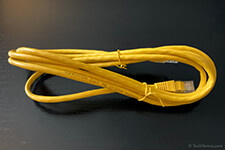Cat 5e
Cat 5e (short for "Category 5 Enhanced") is a type of Ethernet cable. A Cat 5e cable has the same appearance and wiring scheme as a Cat 5 cable, but supports data transfer rates of 1,000 Mbps or one gigabit per second. Therefore, Cat 5e cables are sometimes called Gigabit Ethernet cables.
Cat 5e cables operate on the same 100 MHz frequency as Cat 5 and have the same maximum length of 100 meters before requiring a router or powered signal booster. The primary difference between the two standards is that Cat 5 is only rated for 100 Mbps networks, while Cat 5e supports 1,000 Mbps networks.
While the cables are nearly identical, Cat 5e cables have improved shielding that reduces crosstalk, or interference from adjacent wire pairs. Technically speaking, Cat 5e cables must adhere to stricter IEEE standards in regards to Near-End Crosstalk (NEXT) measurements, which are measured in decibels.
In 2001, Cat 5e began to replace Cat 5 as the most widely used Ethernet cable standard. Today, nearly all wired networks use Cat 5e cables or higher.
 Test Your Knowledge
Test Your Knowledge